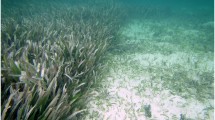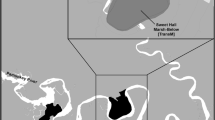Abstract
In terrestrial systems, grazing can have lasting beneficial or damaging effects on plants based on nutrient availability, but it remains unclear how nutrients shape plant responses to grazing in marine systems, especially in resource-poor environments. We chose a phosphorus-limited subtropical turtlegrass Thalassia testudinum meadow in Bermuda to investigate short- and long-term plant responses to repeated herbivory. In a multiyear field experiment, we manipulated nitrogen (N) and phosphorus (P) availability and simulated green turtle Chelonia mydas grazing for 4 months and then tracked recovery through 2 years. In the short term, simulated grazing increased T. testudinum area-specific growth and both foliar N and P content in fertilized plots compared to the control. In unfertilized plots, simulated grazing (trimming) decreased short-term shoot-specific growth and foliar P content. By comparison, long-term data revealed sustained elevated T. testudinum growth after 2 years in fertilized plots in the absence of trimming. While trimming alone did not affect seagrass growth rates 2 years after the treatment application, these plants sustained depleted foliar P concentrations up to 1 year and displayed residual stress symptoms of fewer shoots with thinner leaves. Our data indicate the potential for N and P stoichiometry to influence “cultivation grazing” in marine carbonate environments. Seagrasses apparently responded positively to trimming when the foliar N:P balance did not exceed the “seagrass Redfield ratio” of 30:1. This P-sensitive outcome of herbivory should be evaluated at larger spatial scales and may have important implications for estimating C. mydas carrying capacity of seagrass meadows across resource gradients.




Similar content being viewed by others
References
Almasi MN, Hoskin CM, Reed JK, Milo J (1987) Effects of natural and artificial Thalassia on rates of sedimentation. J Sediment Res 57:901–906. doi:10.1306/212f8c9c-2b24-11d7-8648000102c1865d
Aragones LV, Lawler IR, Foley WJ, Marsh H (2006) Dugong grazing and turtle cropping: Grazing optimization in tropical seagrass systems? Oecologia 149:635–647. doi:10.1007/s00442-006-0477-1
Atkinson MJ, Smith SV (1983) C:N:P ratios of benthic marine plants. Limnol Oceanogr 28:568–574. doi:10.4319/lo.1983.28.3.0568
Babcock HL (1938) The sea-turtles of the Bermuda Islands, with a survey of the present state of the turtle fishing industry. Proc Zool Soc Lond A 107:595–602. doi:10.1111/j.1469-7998.1938.tb00015.x
Bacon JP, Gray JA, Kitson L (2006) Status and conservation of the reptiles and amphibians of the Bermuda islands. Appl Herpetol 3:323–344
Bjorndal KA (1980) Nutrition and grazing behavior of the green turtle Chelonia mydas. Mar Biol 56:147–154. doi:10.1007/BF00397131
Cabaço S, Apostolaki ET, García-Marín P, Gruber R, Hernández I, Martínez-Crego B, Mascaró O, Pérez M, Prathep A, Robinson C, Romero J, Schmidt AL, Short FT, van Tussenbroek BI, Santos R (2013) Effects of nutrient enrichment on seagrass population dynamics: evidence and synthesis from the biomass–density relationships. J Ecol 101:1552–1562. doi:10.1111/1365-2745.12134
Carr JA, D’Odorico P, McGlathery KJ, Wiberg PL (2015) Spatially explicit feedbacks between seagrass meadow structure, sediment and light: habitat suitability for seagrass growth. Adv Water Resour. doi:10.1016/j.advwatres.2015.09.001
Chaloupka M, Bjorndal KA, Balazs GH, Bolten AB, Ehrhart LM, Limpus CJ, Suganuma H, Troëng S, Yamaguchi M (2008) Encouraging outlook for recovery of a once severely exploited marine megaherbivore. Glob Ecol Biogeogr 17:297–304. doi:10.1111/j.1466-8238.2007.00367.x
Christianen MJA, Govers LL, Bouma TJ, Kiswara W, Roelofs JGM, Lamers LPM, van Katwijk MM (2012) Marine megaherbivore grazing may increase seagrass tolerance to high nutrient loads. J Ecol 100:546–560. doi:10.1111/j.1365-2745.2011.01900.x
Christianen MJA, Herman PMJ, Bouma TJ, Lamers LPM, van Katwijk MM, van der Heide T, Mumby PJ, Silliman BR, Engelhard SL, van de Kerk M, Kiswara W, van de Koppel J (2014) Habitat collapse due to overgrazing threatens turtle conservation in marine protected areas. Proc R Soc Lond B Biol 281:1–6. doi:10.1098/rspb.2013.2890
de Mazancourt C, Loreau M, Abbadie L (1998) Grazing optimization and nutrient cycling: when do herbivores enhance plant production? Ecology 79:2242–2252. doi:10.1890/0012-9658(1998)079[2242:GOANCW]2.0.CO;2
Duarte CM (1990) Seagrass nutrient content. Mar Ecol Prog Ser 67:201–207
Ferdie M, Fourqurean JW (2004) Responses of seagrass communities to fertilization along a gradient of relative availability of nitrogen and phosphorus in a carbonate environment. Limnol Oceanogr 49:2082–2094. doi:10.4319/lo.2004.49.6.2082
Fourqurean J, Zieman J (2002) Nutrient content of the seagrass Thalassia testudinum reveals regional patterns of relative availability of nitrogen and phosphorus in the Florida Keys USA. Biogeochemistry 61:229–245. doi:10.1023/A:1020293503405
Fourqurean JW, Zieman JC, Powell GV (1992) Phosphorus limitation of primary production in Florida Bay: evidence from C:N:P ratios of the dominant seagrass Thalassia testudinum. Limnol Oceanogr 37:162–171. doi:10.4319/lo.1992.37.1.0162
Fourqurean J, Manuel S, Coates K, Kenworthy W, Smith S (2010) Effects of excluding sea turtle herbivores from a seagrass bed: overgrazing may have led to loss of seagrass meadows in Bermuda. Mar Ecol Prog Ser 419:223–232. doi:10.3354/meps08853
Fourqurean JW, Manuel SA, Coates KA, Kenworthy WJ, Boyer JN (2015) Water quality, isoscapes and stoichioscapes of seagrasses indicate general P limitation and unique N cycling in shallow water benthos of Bermuda. Biogeosci Discuss 12:9751–9791. doi:10.5194/bgd-12-9751-2015
Greenway M (1974) The effects of cropping on the growth of Thalassia testudinum (König) in Jamaica. Aquaculture 4:199–206. doi:10.1016/0044-8486(74)90034-9
Hansen JCR, Reidenbach MA (2012) Wave and tidally driven flows in eelgrass beds and their effect on sediment suspension. Mar Ecol Prog Ser 448:271–287. doi:10.3354/meps09225
Hata H, Kato M (2006) A novel obligate cultivation mutualism between damselfish and Polysiphonia algae. Biol Lett 2:593–596. doi:10.1098/rsbl.2006.0528
Heithaus MR, Alcoverro T, Arthur R, Burkholder DA, Coates KA, Christianen MJA, Kelkar N, Manuel SA, Wirsing AJ, Kenworthy WJ, Fourqurean JW (2014) Seagrasses in the age of sea turtle conservation and shark overfishing. Front Mar Sci. doi:10.3389/fmars.2014.00028
Hilbert DW, Swift DM, Detling JK, Dyer MI (1981) Relative growth rates and the grazing optimization hypothesis. Oecologia 51:14–18. doi:10.1007/BF00344645
Hunter RD, Russell-Hunter WD (1983) Bioenergetic and community changes in intertidal Aufwuchs grazed by Littorina littorea. Ecology 64:761–769. doi:10.2307/1937199
Jardine H (2015) Sea turtle nest found on beach, 15 hatchlings. Bernews
Jensen HS, McGlathery KJ, Marino R, Howarth RW (1998) Forms and availability of sediment phosphorus in carbonate sand of Bermuda seagrass beds. Limnol Oceanogr 43:799–810. doi:10.2307/2839175
Jones R, Parsons R, Watkinson E, Kendell D (2011) Sewage contamination of a densely populated coral ‘atoll’ (Bermuda). Environ Monit Assess 179:309–324. doi:10.1007/s10661-010-1738-3
Luhar M, Rominger J, Nepf H (2008) Interaction between flow, transport and vegetation spatial structure. Environ Fluid Mech 8:423–439. doi:10.1007/s10652-008-9080-9
Macko SA, Ostrom NE (1994) In: Michener R, Lajtha K (eds) Stable isotopes in ecology and environmental science, 2nd edn. Blackwell Scientific Publications, Cambridge, pp 45–62
Mattson WJ (1980) Herbivory in relation to plant nitrogen content. Annu Rev Ecol Syst 11:119–161. doi:10.1146/annurev.es.11.110180.001003
McGlathery KJ, Reynolds LK, Cole LW, Orth RJ, Marion SR, Schwarzschild A (2012) Recovery trajectories during state change from bare sediment to eelgrass dominance. Mar Ecol Prog Ser 448:209–221. doi:10.3354/meps09574
McNaughton SJ (1984) Grazing lawns: animals in herds, plant form, and coevolution. Am Nat 124:863–886. doi:10.2307/2461305
Moran KL, Bjorndal KA (2005) Simulated green turtle grazing affects structure and productivity of seagrass pastures. Mar Ecol Prog Ser 305:235–247. doi:10.3354/meps305235
Moran KL, Bjorndal KA (2007) Simulated green turtle grazing affects nutrient composition of the seagrass Thalassia testudinum. Mar Biol 150:1083–1092. doi:10.1007/s00227-006-0427-9
Murdoch TJT, Glasspool AF, Outerbridge M, Ward J, Manuel S, Gray J, Nash A, Coates KA, Pitt J, Fourqurean JW, Barnes PA, Vierros M, Holzer K, Smith SR (2007) Large-scale decline in offshore seagrass meadows in Bermuda. Mar Ecol Prog Ser 339:123–130. doi:10.3354/meps339123
Orth RJ, Carruthers TJB, Dennison WC, Duarte CM, Fourqurean JW, Heck KL, Hughes AR, Kendrick GA, Kenworthy WJ, Olyarnik S, Short FT, Waycott M, Williams SL (2006) A global crisis for seagrass ecosystems. Bioscience 56:987–996. doi:10.1641/0006-3568(2006)56[987:AGCFSE]2.0.CO;2
Perry CJ, Dennison WC (2000) Microbial nutrient cycling in seagrass sediments. J Aust Geol Geophys 17:227–231
Plagányi ÉE, Branch GM (2000) Does the limpet Patella cochlear fertilize its own algal garden? Mar Ecol Prog Ser 194:113–122. doi:10.3354/meps194113
Preen A (1995) Impacts of dugong foraging on seagrass habitats: observational and experimental evidence for cultivation grazing. Mar Ecol Prog Ser 124:201–213. doi:10.3354/meps124201
Randall JE (1965) Grazing effect on sea grasses by herbivorous reef fishes in the West Indies. Ecology 46:255–260. doi:10.2307/1936328
Seminoff JA, Allen CD, Balazs GH, Dutton PH, Eguchi T, Haas HL, Hargrove SA, Jensen MP, Klemm DL, Lauritsen AM, MacPherson SL, Opay P, Possardt EE, Pultz SL, Seney EE, Van Houtan KS, Waples RS (2015) Status review of the green turtle (Chelonia mydas) under the Endangered Species Act. NOAA Technical Memorandum NOAA-TM-NMFS-SWFSC-539: 1–571
Taylor JL, Saloman CH, Prest KW Jr (1973) Harvest and regrowth of turtle grass (Thalassia testudinum) in Tampa Bay, Florida. Fish Bull 71:145–148
Thayer GW, Bjorndal KA, Ogden JC, Williams SL, Zieman JC (1984) Role of larger herbivores in seagrass communities. Estuaries 7:351–376. doi:10.2307/1351619
Valentine JF, Heck KL, Busby J Jr, Webb D (1997) Experimental evidence that herbivory increases shoot density and productivity in a subtropical turtlegrass (Thalassia testudinum) meadow. Oecologia 112:193–200. doi:10.2307/4221763
van Dijk JK, van Tussenbroek BI (2010) Clonal diversity and structure related to habitat of the marine angiosperm Thalassia testudinum along the Atlantic coast of Mexico. Aquat Bot 92:63–69. doi:10.1016/j.aquabot.2009.10.005
van Tussenbroek BI, Cortés J, Collin R, Fonseca AC, Gayle PMH, Guzmán HM, Jácome GE, Juman R, Koltes KH, Oxenford HA, Rodríguez-Ramirez A, Samper-Villarreal J, Smith SR, Tschirky JJ, Weil E (2014) Caribbean-wide, long-term study of seagrass beds reveals local variations, shifts in community structure and occasional collapse. PLoS One 9:e90600. doi:10.1371/journal.pone.0090600
Williams SL (1988) Thalassia testudinum productivity and grazing by green turtles in a highly disturbed seagrass bed. Mar Biol 98:447–455. doi:10.1007/BF00391121
Woodin SA (1977) Algal “gardening” behavior by nereid polychaetes: effects on soft-bottom community structure. Mar Biol 44:39–42. doi:10.1007/BF00386902
Zieman JC (1974) Methods for the study of the growth and production of turtle grass, Thalassia testudinum König. Aquaculture 4:139–143. doi:10.1016/0044-8486(74)90029-5
Zieman JC, Iverson RL, Ogden JC (1984) Herbivory effects on Thalassia testudinum leaf growth and nitrogen content. Mar Ecol Prog Ser 15:151–158. doi:10.3354/meps015151
Acknowledgments
We are indebted to Rowena Day, Sarah Gosling, Nick Lewis and Russell Smith for assistance with simulated turtle grazing and other scientific diving. Mark Minton provided statistics advice. This research was funded by grants from the US Environmental Protection Agency (EPA) under the STAR Graduate Fellowship Program, the Marine Environmental Program Lab, Bermuda Institute of Ocean Sciences (BIOS) Grant-in-Aid and the Moore Endowment at University of Virginia. We dedicate this manuscript to Peter Outerbridge (1928–2014) whose keen observations returned clever insights about Bermuda’s marine environment. This is BIOS contribution 3006. The views expressed within belong to the authors and were not subject to EPA review.
Author information
Authors and Affiliations
Corresponding author
Additional information
Responsible Editor: F. Weinberger.
Reviewed by K. McDermid and an undisclosed expert.
Rights and permissions
About this article
Cite this article
Holzer, K.K., McGlathery, K.J. Cultivation grazing response in seagrass may depend on phosphorus availability. Mar Biol 163, 88 (2016). https://doi.org/10.1007/s00227-016-2855-5
Received:
Accepted:
Published:
DOI: https://doi.org/10.1007/s00227-016-2855-5




